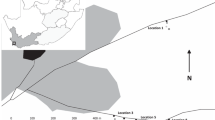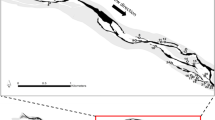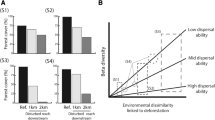Abstract
Refugia within successional mosaics where localized conditions inhibit successional replacement may support large abundances of early colonizing species and their coexistence with strongly competitive late colonizers. Numerous habitats have been hypothesized as refugia from succession with important landscape-scale consequences from export of propagules, but their commonness among ecological systems is unknown because tests to demonstrate their existence have not been formulated and applied. In this study on an intertidal model system, an early successional tubeworm was highly abundant in a hypothesized refuge habitat-type where late successional algae could not establish. In adjacent non-refuge habitat, a change in species dominance involving tubeworms shifting to algae occurred from early to late succession following experimentally induced disturbance. No such change occurred in refuges where early successional tubeworm populations steadily increased throughout succession. Tubeworm recruitment was reduced in the presence of late successional algae, likely from competition in the non-refuge. The presence of habitats providing refugia from succession may have important consequences, e.g. promoting low but consistent levels of local-scale coexistence of early and late successional taxa observed here even without disturbance. Experimental tests such as these to identify refugia from succession will be useful to apply to larger-scale land/seascapes if, as in this study, the scale of experimentation is optimized for the species and processes of interest. If the inferences from these results are extrapolated to larger-scale systems, they may inform our understanding of spread of early successional species such as weeds with large impacts that are potentially influenced by this landscape feature.


Similar content being viewed by others
Data availability statement
The datasets analysed during the current study are available from the corresponding author on reasonable request.
References
Amarasekare P (2000) Coexistence of competing parasitoids on a patchily distributed host: local vs. spatial mechanisms. Ecology 81:1286–1296. https://doi.org/10.1890/0012-9658(2000)081[1286:COCPOA]2.0.CO;2
Amarasekare P, Nisbet RM (2001) Spatial heterogeneity, source-sink dynamics, and the local coexistence of competing species. Am Nat 158:572–584. https://doi.org/10.1086/323586
Anderson MJ, Walsh DCI (2013) PERMANOVA, ANOSIM, and the Mantel test in the face of heterogeneous dispersions: What null hypothesis are you testing? Ecol Monogr 83:557–574. https://doi.org/10.1890/12-2010.1
Baskin JM, Baskin CC (1988) Endemism in rock outcrop plant communities of unglaciated eastern United States: an evaluation of the roles of the edaphic, genetic and light factors. J Biogeogr 15:829–840. https://doi.org/10.2307/2845343
Bertness MD, Gough L, Shumway SW (1992) Salt tolerances and the distribution of fugitive salt marsh plants. Ecology 73:1842–1851. https://doi.org/10.2307/1940035
Bulleri F (2006) Duration of overgrowth affects survival of encrusting coralline algae. Mar Ecol Prog Ser 321:79–85. https://doi.org/10.3354/meps321079
Burke A (2003) Inselbergs in a changing world—global trends. Divers Distrib 9:375–383. https://doi.org/10.1046/j.1472-4642.2003.00035.x
Castillo-Escrivà A, Aguilar-Alberola JA, Mesquita-Joanes F (2017) Spatial and environmental effects on a rock-pool metacommunity depend on landscape setting and dispersal mode. Freshw Biol 62:1004–1011
Chase JM (2003) Community assembly: when should history matter? Oecologia 136:489–498. https://doi.org/10.1007/s00442-003-1311-7
Connell JH, Sousa WP (1983) On the evidence needed to judge ecological stability or persistence. Am Nat 121:789–824. https://doi.org/10.1086/284105
Crowder LB, Lyman SJ, Figueira WF, Priddy J (2000) Source-sink population dynamics and the problem of siting marine reserves. Bull Mar Sci 66:799–820
Dayton PK (1975) Experimental evaluation of ecological dominance in a rocky intertidal algal community. Ecol Monogr 45:137–159. https://doi.org/10.2307/1942404
Fahrig L, Coffin DP, Lauenroth WK, Shugart HH (1994) The advantage of long-distance clonal spreading in highly disturbed habitats. Evol Ecol 8:172–187. https://doi.org/10.1007/BF01238248
Hubbell SP (2001) The unified neutral theory of species abundance and diversity. Princeton University Press, Princeton
Huston M, Smith T (1987) Plant succession: life history and competition. Am Nat 130:168–198. https://doi.org/10.1086/284704
Jelinski DE (2015) On a landscape ecology of a harlequin environment: the marine landscape. Landsc Ecol 30:1–6. https://doi.org/10.1029/2001GB001449
Johnson EA, Miyanishi K (2008) Testing assumptions of chronosequences in succession. Ecol Lett 11:419–431. https://doi.org/10.1111/j.1461-0248.2008.01173.x
Keats DW, Knight MA, Pueschel CM (1997) Antifouling effects of epithallial shedding in three crustose coralline algae (Rhodophyta, Coralinales) on a coral reef. J Exp Mar Biol Ecol 213:281–293. https://doi.org/10.1016/S0022-0981(96)02771-2
Kneitel JM, Chase JM (2004) Trade-offs in community ecology: linking spatial scales and species coexistence. Ecol Lett 7:69–80. https://doi.org/10.1046/j.1461-0248.2003.00551.x
Levine JM (2003) A patch modeling approach to the community-level consequences of directional dispersal. Ecology 84:1215–1224. https://doi.org/10.1890/0012-9658(2003)084[1215:APMATT]2.0.CO;2
Lipcius RN, Stockhausen WT, Eggleston DB, Marshall LS Jr, Hickey B (1997) Hydrodynamic decoupling of recruitment, habitat quality and adult abundance in the Caribbean spiny lobster: source-sink dynamics? Mar Freshw Res 48:807–816. https://doi.org/10.1071/MF97194
Liversage K (2012) Ecology of cryptic habitats under intertidal boulders. PhD thesis, The University of Sydney
Liversage K, Kotta J (2018) Unveiling commonalities in understudied habitats of boulder reefs: life-history traits of the widespread invertebrate and algal inhabitants. Mar Biol Res 14:655–671. https://doi.org/10.1080/17451000.2018.1510180
Liversage K, Cole V, Coleman R, McQuaid C (2017) Availability of microhabitats explains a widespread pattern and informs theory on ecological engineering of boulder reefs. J Exp Mar Biol Ecol 489:36–42. https://doi.org/10.1016/j.jembe.2017.01.013
Loreau M, DeAngelis DL (1997) Source–sink dynamics and the coexistence of species on a single resource. Theor Popul Biol 51:79–93. https://doi.org/10.1006/tpbi.1997.1298
Ludford A, Cole VJ, Porri F, McQuaid CD, Nakin MDV (2012) Testing source-sink theory: the spill-over of mussel recruits beyond marine protected areas. Landsc Ecol 27:859–868. https://doi.org/10.1007/s10980-012-9739-y
Marks PL (1983) On the origin of the field plants of the northwestern United States. Am Nat 122:210–228. https://doi.org/10.1086/284131
McGuinness KA (1987) Disturbance and organisms on boulders II. Causes of patterns in diversity and abundance. Oecologia 71:420–430. https://doi.org/10.1007/BF00378716
McGuinness KA (1988) Short-term effects of sessile organisms on colonization of intertidal boulders. J Exp Mar Biol Ecol 116:159–175. https://doi.org/10.1016/0022-0981(88)90053-6
Meiners SJ, Cadotte MW, Fridley JD, Pickett STA, Walker LR (2015) Is successional research nearing its climax? New approaches for understanding dynamic communities. Funct Ecol 29:154–164. https://doi.org/10.1111/1365-2435.12391
Mouquet N, Loreau M (2003) Community patterns in source-sink metacommunities. Am Nat 162:544–557. https://doi.org/10.1086/378857
Mouquet N, Miller T, Daufresne T, Kneitel JM (2006) Consequences of varying regional heterogeneity in source–sink metacommunities. Oikos 113:481–488. https://doi.org/10.1111/j.2006.0030-1299.14582.x
Platt WJ, Connell JH (2003) Natural disturbances and directional replacement of species. Ecol Monogr 73:507–522. https://doi.org/10.1890/01-0552
Porembski S, Szarzynski J, Mund J, Barthlott W (1996) Biodiversity and vegetation of small-sized inselbergs in a West African rain forest (Taı, Ivory Coast). J Biogeogr 23:47–55. https://doi.org/10.1046/j.1365-2699.1996.00982.x
Prach K, Walker LR (2011) Four opportunities for studies of ecological succession. Trends Ecol Evol 26:119–123. https://doi.org/10.1016/j.tree.2010.12.007
Pulliam HR (1988) Sources, sinks, and population regulation. Am Nat 132:652–661. https://doi.org/10.1086/284880
Rosenzweig ML (1995) Species diversity in space and time. Cambridge University Press, Cambridge
Samhouri JF, Steele MA, Forrester GE (2009) Inter-cohort competition drives density dependence and selective mortality in a marine fish. Ecology 90:1009–1020. https://doi.org/10.1890/07-1161.1
Schröder A, Persson L, De Roos AM (2005) Direct experimental evidence for alternative stable states: a review. Oikos 110:3–19. https://doi.org/10.1111/j.0030-1299.2005.13962.x
Smith TM, York PH, Macreadie PI, Keough MJ, Ross DJ, Sherman CDH (2016) Recovery pathways from small-scale disturbance in a temperate Australian seagrass. Mar Ecol Prog Ser 542:97–108. https://doi.org/10.3354/meps11531
Sousa WP (1979) Disturbance in marine intertidal boulder fields: the nonequilibrium maintenance of species diversity. Ecology 60:1225–1239. https://doi.org/10.2307/1936969
Swanson ME, Franklin JF, Beschta RL, Crisafulli CM, DellaSala DA, Hutto RL, Lindenmayer DB, Swanson FJ (2010) The forgotten stage of forest succession: early-successional ecosystems on forest site. Front Ecol Environ 9:117–125. https://doi.org/10.1890/090157
Tabarelli M, Aguiar AV, Girao LC, Peres CA, Lopes AV (2010) Effects of pioneer tree species hyperabundance on forest fragments in northeastern Brazil. Conserv Biol 24:1654–1663. https://doi.org/10.1111/j.1523-1739.2010.01529.x
Tischew S, Baasch A, Grunert H, Kirmer A (2013) How to develop native plant communities in heavily altered ecosystems: examples from large-scale surface mining in Germany. Appl Veg Sci 17:288–301. https://doi.org/10.1111/avsc.12078
Trekels H, Vanschoenwinkel B (2019) Both local presence and regional distribution of predator cues modulate prey colonisation in pond landscapes. Ecol lett 22:89–97. https://doi.org/10.1111/ele.13170
Underwood AJ (1978) An experimental evaluation of competition between three species of intertidal prosobranch gastropods. Oecologia 33:185–202. https://doi.org/10.1007/BF00344847
Underwood AJ (1997) Experiments in ecology: their logical design and interpretation using analysis of variance. Cambridge University Press, Cambridge
Underwood AJ (2000) Experimental ecology of rocky intertidal habitats: what are we learning? J Exp Mar Biol Ecol 250:51–76. https://doi.org/10.1016/S0022-0981(00)00179-9
Vlam M, van der Sleen P, Groenendijk P, Zuidema PA (2017) Tree age distributions reveal large-scale disturbance-recovery cycles in three tropical forests. Front Plant Sci. https://doi.org/10.3389/fpls.2016.01984
Walker LR, Wardle DA, Bardgett RD, Clarkson BD (2010) The use of chronosequences in studies of ecological succession and soil development. J Ecol 98:725–736. https://doi.org/10.1111/j.1365-2745.2010.01664.x
Wiens JA, Milne BT (1989) Scaling of 'landscapes' in landscape ecology, or, landscape ecology from a beetle's perspective. Landsc Ecol 3:87–96. https://doi.org/10.1007/BF00131172
Wright JT, Gribben PE (2017) Disturbance-mediated facilitation by an intertidal ecosystem engineer. Ecology 98:2425–2436. https://doi.org/10.1002/ecy.1932
Wright JT, Gribben PE, Latzel S (2016) Native ecosystem engineer facilitates recruitment of invasive crab and native invertebrates. Biol Invasions 18:3163–3173. https://doi.org/10.1007/s10530-016-1206-2
Zimmerman JK, Everham EM III, Waide RB, Lodge DJ, Taylor CM, Brokaw NV (1994) Responses of tree species to hurricane winds in subtropical wet forest in Puerto Rico: implications for tropical tree life histories. J Ecol 82:911–922. https://doi.org/10.2307/2261454
Acknowledgements
This work was supported by The University of Sydney and was funded by an APA scholarship. I thank the peer reviewers for comments that improved an earlier version of the manuscript. I am grateful to J. Kotta for suggestions on the manuscript. Discussion and advice from R. A. Coleman, M. G. Chapman, A. N. S. Palmer, W. F. Figueira and colleagues at the EICC is much appreciated.
Author information
Authors and Affiliations
Contributions
KL conceived, designed and performed the experiments, analysed the data, and wrote the manuscript.
Corresponding author
Ethics declarations
Conflict of interest
The author declares he has no conflict of interest.
Additional information
Communicated by Jeremy Long.
Electronic supplementary material
Below is the link to the electronic supplementary material.
Rights and permissions
About this article
Cite this article
Liversage, K. Experiments determining if habitat mosaics include the refugia from succession theorized to promote species coexistence. Oecologia 194, 193–204 (2020). https://doi.org/10.1007/s00442-020-04751-4
Received:
Accepted:
Published:
Issue Date:
DOI: https://doi.org/10.1007/s00442-020-04751-4




